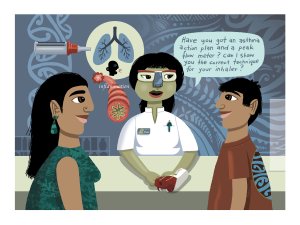Academic pharmacist Nataly Martini discusses the medical management of asthma in adults and adolescents, which has evolved to prioritise early anti-inflammatory treatment. She also explains how to improve patient outcomes by proactively identifying poor asthma control and supporting equitable access to education and treatment
Management of diabetes webinar 3 - assessment answers
Management of diabetes webinar 3 - assessment answers

Below are the answers to the assessment from the webinar: Practical management for patients with diabetes
Record your score in the Capture box at the bottom of the page for your own records.
1. Which of the following are perceived barriers for CLINICIANS when initiating or intensifying insulin in their patients?
f. All of the above
2. Which of the following are perceived PATIENT barriers or delays to insulin initiation and intensification?
g. All of the above
3. Which TWO of the following are potential patient errors when using insulin?
a. A 60kg woman injecting insulin into the triceps muscle with an 8mm needle at a 90 degree angle to the skin
f. Using a HumaPen cartridge in a NovoPen 4
4. To avoid potential errors in insulin use, healthcare providers should do which TWO of the following?
a. Get familiar with the different-acting insulin preparations (short/intermediate, biphasic, mixed) to avoid confusion
b. Ensure the full brand names of insulins are clearly specified on prescriptions
5. Which TWO of the following statements about insulin delivery devices are correct?
a. Continuous subcutaneous insulin pumps deliver rapid-acting insulin only
c. Each branded reusable insulin pen must be matched with its complementary brand of insulin cartridge
6. Select TWO responses that correctly complete the following sentence. When administering insulin:
a. into the abdomen, the injection should be ≥1cm above the symphysis pubis, ≥1cm below the lowest rib and ≥1cm away from the umbilicus
c. the abdomen is recommended over the thigh, as the rate of insulin absorption is faster and there is less risk of inappropriate needle placement
7. Lipohypertrophy is a common complication associated with insulin use. Which THREE of the following statements are CORRECT?
a. Absorption of insulin into sites of lipohypertrophy can lead to hyperglycaemia, unexpected hypoglycaemia or increased glucose variability
c. Lipohypertrophy can manifest clinically as induration of fat tissue
e. Lipohypertrophy may develop from repeated injections into the same localised area
8. Which THREE of the following statements regarding hypoglycaemia and/or its treatment are CORRECT?
b. Glucagon should not be given to someone with pheochromocytoma
d. Pallor and tremor can be symptoms of mild to moderate hypoglycaemia
f. Treatment of a severe hypoglycaemia event in a conscious person can be by oral administration of rapidly absorbed carbohydrate
9. Which THREE statements about people with diabetes taking insulin in specific situations such as driving and exercise are CORRECT?
a. Blood glucose levels should be tested before driving
c. Most people rely on symptoms to detect hypoglycaemia while driving
e. Should hypoglycaemia occur during driving, the driver should stop, treat the hypoglycaemia and wait one hour before driving again
10. Select THREE responses that correctly complete the following sentence. Acute illness that is not quickly and appropriately managed in people with diabetes taking insulin:
a. may put them at risk of a hyperosmolar hyperglycaemic state
b. requires rapid-acting insulin regardless of blood glucose levels if ketone levels are >0.6mmol/L
e. should prompt more frequent blood glucose testing





